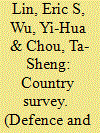|
|
|
Sort Order |
|
|
|
Items / Page
|
|
|
|
|
|
|
| Srl | Item |
| 1 |
ID:
113329


|
|
|
|
|
| Publication |
2012.
|
| Summary/Abstract |
In this article we survey military spending, the evolution of national defense policy, and the role that defense spending played in economic activities in Taiwan from 1952 to 2009. With the ongoing cross-Strait dialogue and closer commercial ties between Taiwan and China, the share of military spending in government expenditures (or GDP) has tended to gradually decline, which is in accordance with the change in defense policy from an offensive posture to a defensive-oriented attitude. In addition, we investigate the defense spending-inflation nexus in Taiwan. The multivariate structural change test identifies two break points and three regimes are categorized accordingly. The Granger causality test based on the VAR model reveals that the heavy defense burden in Taiwan during 1952-71 (the first regime) is essentially an important factor causing the higher price levels. However, when the tension across the Taiwan Strait is alleviated as well as the defense-oriented policy adopted, the military spending no longer plays a crucial role in determining inflation in the recent two regimes. Sensitivity analysis confirms that our results are robust to different model specifications.
|
|
|
|
|
|
|
|
|
|
|
|
|
|
|
|
| 2 |
ID:
136966


|
|
|
|
|
| Summary/Abstract |
This article examines the relationship between defense and social welfare expenditures using a panel of 29 OECD countries from 1988 to 2005. It is quite difficult to take into account the simultaneous channels empirically through which the eventual allocation of defense and welfare spending is determined for the guns-and-butter argument. Taking advantage of our collected panel data-set, the panel generalized method of moments method is adopted to control the country-specific heterogeneity and to mitigate the potential simultaneity problem. The main finding of this article suggests a positive trade-off between military spending and two types of social welfare expenditures (i.e. education and health spending). One of the reasons may be that the OECD countries are more supportive of the social welfare programs; therefore, when the military spending is increased (e.g. military personnel and conscripts), the government may raise the health and education spending as well.
|
|
|
|
|
|
|
|
|
|
|
|
|
|
|
|
| 3 |
ID:
155301


|
|
|
|
|
| Summary/Abstract |
Dunne, Smith, and Willenbockel (2005) argue that the mainstream growth literature has not found military spending to be a significant determinant of economic growth, yet much of the defense economics literature has noted significant effects. This paper revisits this issue by using a DSGE-VAR approach, combining both theoretical and empirical methods. We present that the DSGE approach (estimated with the Bayesian technique) and the Bayesian VAR with the Minnesota Prior both lead to worse in-sample fit than our proposed DSGE-VAR framework. The DSGE-VAR approach reveals that a positive military spending shock boosts the U.S. economy, increasing per capita real GDP growth, consumption, inflation and interest rate. Our results are robust to alternative model specifications. Future investigations such as exploring an optimal military spending policy could adopt the approach in this paper to determine the best model – empirical, theoretical, or a combination of the two.
|
|
|
|
|
|
|
|
|
|
|
|
|
|
|
|
| 4 |
ID:
090918


|
|
|
|
|
| Publication |
2009.
|
| Summary/Abstract |
The relationship between military spending and economic inequality is not well documented within the empirical literature, while numerous studies have uncovered the linkages between military spending and other macroeconomic variables, such as economic growth, unemployment, purchasing power parity, black market premium, poverty and investment. The purpose of this article is to examine the causal relationship between military spending and inequality using BVC and SIPRI data across 58 countries from 1987 to 1999. Panel unit root tests indicate that two inequality measures (Theil and EHII) under consideration are likely to be non-stationary. The authors' work addresses the adverse implications of modeling with non-stationary variables, since this omission casts serious doubt on the reliability of the relationship between military spending and inequality. The recently developed panel Granger non-causality tests provide no evidence to support the causal relationship in either direction between the military spending and the change in economic inequality. The results are consistently robust to alternative data sources for military spending, to alternative definitions of the inequality measures, to the log transformation of the military spending, to the deletion of some data points, and to the division of OECD and non-OECD countries. Finally, the impulse responses and variance decompositions based on the panel vector autoregressive regression model are consistent with the findings from Granger non-causality tests.
|
|
|
|
|
|
|
|
|
|
|
|
|
|
|
|
|
|
|
|
|